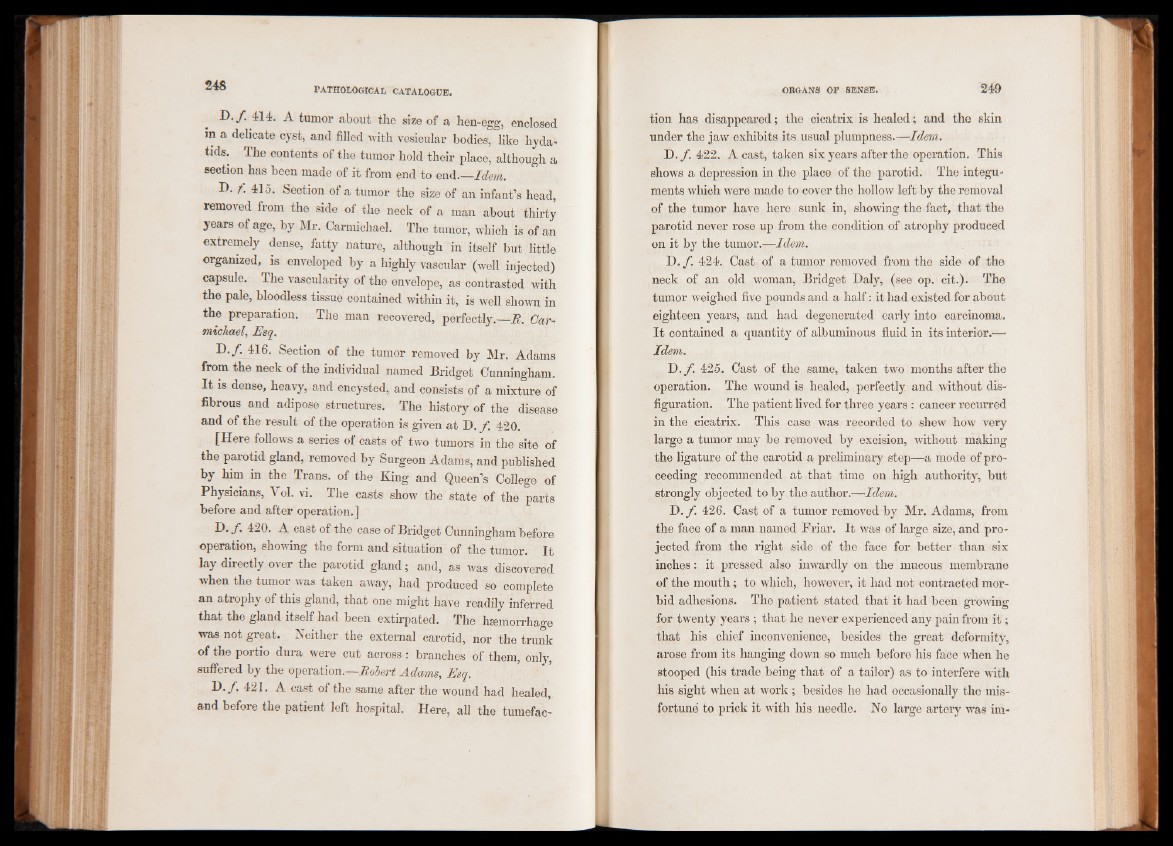
Ji.f. 414. A tumor about the size of a hen-egg, enclosed
in a delicate cyst, and filled with vesicular bodies, like hydatids.
The contents of the tumor hold their place, although a
section has been made of it from end to eml.—Idem.
IX f 415. Section of a tumor the size of an infant’s head,
removed from the side of the neck of a man about thirty
years of age, by Mr. Carmichael. The tumor, which is of an
extremely dense, fatty nature, although in itself but little
organized, is enveloped by a highly vascular (well injected)
capsule. The vascularity of the envelope, as .contrasted with
the pale, bloodless tissue contained within it, is well shown in
the preparation. The man recovered, michael, Esq. perfectly.—.#. CarD.
ƒ. 416. Section of the tumor removed by Mr. Adams
from the neck of the individual named Bridget Cunningham.
It is dense, heavy, and encysted, and consists of a mixture of
fibrous and adipose structures. The history of the disease
and of the result of the operation is given at D. f. 420.
[Here follows a series of casts of two tumors in the site of
the parotid gland, removed by Surgeon Adams, and published
by him in the Trans, of the King and Queen’s College of
Physicians, Vol. vi. The casts show the state of the parts
before and after operation.]
IX 420. A cast of the case of Bridget Cunningham before
operation, showing the form and situation of the tumor. It
lay directly over the parotid gland; and, as was discovered
when the tumor was taken away, had produced so complete
an atrophy of this gland, that one might have readily inferred
that the gland itself had been extirpated. The hemorrhage
was not great. Neither the external carotid, nor the trunk
of the portio dura were cut across : branches of them, only,
suffered by the operation.—Robert Adams, Esq.
D. ƒ. 421. A cast of the same after the wound had healed,
and before the patient left hospital. Here, all the tumefaction
has disappeared; the cicatrix is healed; and the skin
under the jaw exhibits its usual plumpness.—Idem.
D. ƒ. 422. A cast, taken six years after the operation. This
shows a depression in the place of the parotid. The integuments
which were made to cover the hollow left by the removal
of the tumor have here sunk in, showing the fact, that the
parotid never rose up from the condition of atrophy produced
on it by the tumor.—Idem.
D. ƒ. 424. Cast of a tumor removed from the side of the
neck of an old woman, Bridget Daly, (see op. cit.). The
tumor weighed five pounds and a half: it had existed for about
eighteen years, and had degenerated early into carcinoma.
It contained a quantity of albuminous fluid in its interior.—
Idem.
D.ƒ. 425. Cast of the same, taken two months after the
operation. The wound is healed, perfectly and without disfiguration.
The patient lived for three years : cancer recurred
in the cicatrix. This case was recorded to shew how very
large a tumor may be removed by excision, without making
the ligature of the carotid a preliminary step—a mode of proceeding
recommended at that time on high authority, but
strongly objected to by the author.—Idem.
D, f 426. Cast of a tumor removed by Mr. Adams, from
the face of a man named Friar. It was of large size, and projected
from the right side of the face for better than six
inches: it pressed also inwardly on the mucous membrane
of the mouth; to which, however, it had not contracted morbid
adhesions. The patient stated that it had been growing
for twenty years ; that he never experienced any pain from it;
that his chief inconvenience, besides the great deformity,
arose from its hanging down so much before his face when he
stooped (his trade being that of a tailor) as to interfere with
his sight when at work ; besides he had occasionally the misfortune
to prick it with his needle. No large artery was im